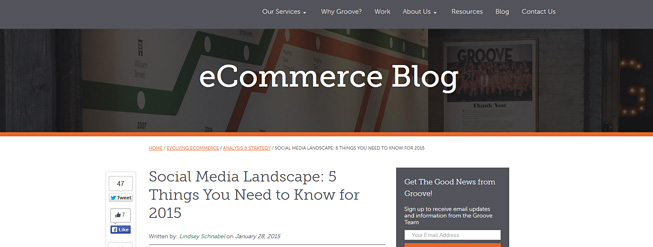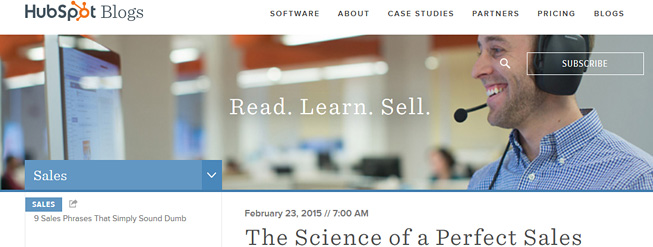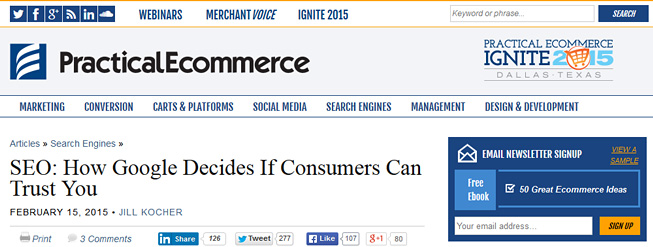The Top 20 Ecommerce Blog Posts of the Year…so far!

If you’re one of the ever increasing number of people already running or thinking about setting up an online business, you’ll probably know that keeping up with the latest developments in search engine optimisation, digital marketing, ecommerce and social media can be a full-time job in itself.
There are literally hundreds of websites and experts out there more than willing to help, but where do you find the time to work out which you need to read and follow? Doing that…well, it can be a full-time job in itself!
You’ll be glad to know, then, that we’ve done a lot of the legwork on your behalf, so that you can go straight to the information that is worth reading and the tools and tips that are worth using. So, here are 20 of the best blogs written so far this year that we think you might find particularly useful.
Getting the basics right
1 5 Easy to Use Online Logo Makers to Design Your Brand (Shopify)
Before you even start marketing your business and selling your products and/or services, you want your potential customers to find themselves landing on a website that looks good. Giving your site a professional image with an impressive logo, however, can be an expensive business, as professional designers are not in the habit of doing anything cheaply! The average startup tends not to have the money to throw at these kind of things from the off, so this handy blog introduces you to a few easy, but effective, ways of doing it yourself.
2 15 SEO Best Practices for Structuring URLs (Moz)
There are many things you can do to make your site more visible. One of the more important, but least discussed, ways, is to make sure you optimise your url’s properly – and it’s something that’s worth getting right from the outset, because it can be a time-consuming and potentially damaging matter to put right later, especially if you’ve earned yourself some nice backlinks in the interim. This comprehensive Moz blog tells you all you need to know – and a little bit more!
3 12 handy tips for writing better web copy (Econsultancy)
If you’ve not written anything substantial since the day you walked out of full-time education and into the real world, the prospect of having to put together a whole website full of convincing copy can be pretty intimidating. Like all things, however, it should be straightforward, and this no-nonsense blog from Econsultancy strips away the myths to make sure you focus on keeping it simple and getting your message across.
Reaching Out – 1: SEO
4 Keyword Strategy: Then vs. Now (Search Engine Watch)

Whatever you’re selling online, be it your skills as a maker of fine porcelain animals, your expertise in boxes and packaging or your vast knowledge of digital marketing techniques, it’s no good if people can’t find you to take advantage. In the old days, you just crammed your keywords as many times as you could into every nook and cranny of your site and – hey presto! – Google would often as not display you on the first page of their results. Those days are long gone now – although you’ll still find many sites still trying it on. This is a useful and very interesting summary of how the art has moved on, and what you now need to be doing to attract the attention of the Google spiders rather than their spamming monitors.
5 SEO in 2015: Things You Need to Consider (Tweak Your Biz)
Sometimes SEO can feel like you’re constantly having to battle the latest whims, diktats and moods of Google Central. Yesterday your SEO policy meant you were on page one; today you’ve got a manual penalty and your traffic has dropped off the radar. Backlinks: good or bad? Depends on what kind of backlinks they are and whether Matt Cutts woke up on the wrong side of the bed today. Okay, we’re exaggerating for effect, but if you’ve been in the business for any time at all, you’ll know just what we mean. All of which is a long way round of saying that another blog about best SEO practice in 2015 won’t do you any harm.
6 Selling with Google Adwords on a Tiny Budget (Boot Strapping Ecommerce)
If you can’t crack the organic SEO conundrum, you can always play the Google game by committing some of your precious marketing budget to Adwords. But that can be an expensive business – and if you’re not an expert, you could quickly find yourself outsmarted by more savvy operators competing for the same customers. It’s a lot like ebay: there’s a knack to it, and the longer you do it, the better you get at it. Until you get to that point, however, you need all the help you can get, and this blog is a great starting point – not least, because it recognises from the outset that we don’t all have a big budget to play with!
7 10 Best Practices for an SEO-Savvy Ecommerce Store (Volusion)
The blogs we’ve featured in this section so far have, for the most part, been chiefly concerned with the subject of keywords – important stuff, because you want the people visiting your site to be in the market for what you’re selling. But there’s a lot, lot more to SEO than keywords, and here’s a bit more advice on how to stay on top of your site and make sure everything is working together to give you the best chance of attracting those new customers.
Reaching Out – 2: Social
8 Social Media Landscape: 5 Things You Need to Know for 2015 (Groove Commerce)

Like SEO, social media is a constantly changing environment. Different sites and platforms go in and out of fashion – you do know there are other social media sites you need to be on apart from Facebook and Twitter, don’t you? – and staying on top of where you need to be focusing your efforts isn’t always easy unless you’ve got far too much time on your hands. This is a handy summary of the likely trends for 2015 in one short, sharp and easy-to-read blog, courtesy of those groovy people at Groove Commerce.
9 9 Steps to Creating A Powerful LinkedIn Profile (Jeff Bullas)
So, you’re happy you’ve now got Twitter and Facebook licked, and, courtesy of the previous blog, you’re already thinking about some of the up-and-coming sites you might need to turn your mind to over the course of the next 12 months. What about LinkedIn, though? Let me guess: you’ve got a personal profile there, complete with your cv; you’ve connected to a few friends and a few business colleagues, and that’s about it. If that’s the case, you’re missing out – Jeff Bullas reckons that this is one of the best places to spread the word about who you are and what you do among the business community. He also reckons that he knows the best way to get yourself noticed – and who are we to argue?
10 Essential Google Analytics Resources for Marketers: A Complete Guide (Social Media Examiner)
Of course, setting yourself up on all those social media sites is one part of the story, and engaging successfully with your Friends, Likers, Followers and so on is another. But you may be wasting your time if you’re not analysing the result of all that activity, to see what is working and what isn’t. Most of us are used to running Analytics on our websites, to see where those visitors are coming from and what they’re doing once they get there, but it’s easy to forget that you can do just the same with social media. Social Media Examiner have put together a very comprehensive guide we probably all need to follow.
Reaching Out – 3: Email
11 What’s Hot for Email Marketing This Year? (Small Business Trends)
Every digital marketer needs to have this message repeated to them several times a day: email marketing is still one of the most effective means of earning, keeping, and winning back customers. But that doesn’t mean you can keep on doing the same old thing year after year. Like everything else, you need to move with the times, use new technologies and be aware of how your customers are working these days. The people at Small Business Trends know all this and have been kind enough to share their thoughts about the current state of email marketing with us on this blog.
12 The Science of a Perfect Sales Email (Hubspot)

Given the above, we can hopefully all agree that the email is still a key weapon in the modern digital marketing armoury. On the other hand, not everyone says the same about infographics. What we say is that they can be, especially if they’re as well put together as this one over on Hubspot. Implisit have looked at the results of a cool 250,000 sales emails (yes, that is a quarter of a million) to see what works and what doesn’t. Everything from the length of the subject line and the number of words in the email to whether you include a photo next to a signature has been analysed. The results are, to put it mildly, fascinating.
Converting
13 6 Must-Know Tips for Successful A/B Testing (Crazy Egg)
14 12 A/B Testing Mistakes That Cost You Money (Infinite Conversions)
No matter how many visitors you get to your ecommerce store, if they’re not going on to buy things from you or engage your services, it’s all something of a waste of time. These two blogs are all about the best practices and worst pitfalls of A/B testing – basically, trying two ways of setting up some aspect of your site and seeing which works best. It’s one of the most worthwhile processes any ecommerce operator can engage in, because the results tell you which set-up is most likely to turn an interested visitor into a paying customer.
15 Driving Higher Conversions on Smartphones (Internet Retailer)
As the technology gets smaller and faster, we can all of us do more of our business on the move. The latest research, quoted in this Internet Retailer blog, tells us that in January 2015, smartphone and tablet users accounted for over half of all visits to online retailers, yet accounted for less than a quarter of all sales. Obviously there’s an element of ‘browse now, buy later’, but turning more of those mobile visits into immediate sales is worth a bit of effort – and you could do worse than to start with this handy introduction to the subject.
16 6 Best Practices to Improve Checkout Conversions and Reduce Abandoned Cart (Big Commerce)
17 How to Prevent Users from Bouncing Off Your Site (Chicago Style SEO)
Think like a seller and you’ll get a salesman’s website. Think like a user, or a buyer, and you may well end up with a site that sells more. Sounds simple, doesn’t it? Of course, it’s a little more complicated than that, but these are a couple of really nice pieces which are basically telling us – with some practical ideas and examples to think about – what we really all ought to know, but too many of us can easily forget.
Odds and Ends
18 SEO: How Google Decides If Consumers Can Trust You (Practical Ecommerce)

Obviously, this could have gone in the SEO section, but we think trust is a separate issue, and one of such importance that this should stand apart. Everyone should now be aware that independent customer reviews form one of the most basic building blocks of online trust, but there’s a whole lot more to it than that. And, of course, convincing customers you’re trustworthy is hard enough; convincing Google is at a whole new level of difficulty. But if they bump you up their rankings on the back of it – and this is one of the key developing metrics Google will be concentrating on more and more in the future – getting that ultimate badge of recognition could be like all your birthdays coming at once.
19 12 ‘Supermarketing’ Secrets for Ecommerce from the Grocery Aisle (Get Elastic)
Supermarkets are some of the smartest operators around when it comes to clever tricks designed to get the customer to spend more than they intend to: special offers; the deliberate placement of particular items in certain parts of the shop; selling some things so cheaply that they surely can’t be making any money on them (aka ‘loss leaders’); some products always seeming to be in a different place to where they were last week, so you have to hunt for them (mushrooms, usually!). Now, you could really annoy regular customers if you start hiding products in different parts of your website (relax, we’re not going to move our postal boxes into the Polythene Packaging section and make you look for them!), but there are many important lessons to be learned from supermarkets that can be applied to almost any ecommerce store – and Get Elastic have explained them very nicely indeed, thank you.
20 Three eCommerce Growth Hacks that Will Boost Your Sales and Revenues (60 Second Marketer)
Growth Hacking, in case you’ve not heard of it before, is the latest ‘big thing’ in digital marketing. It is described by Wikipedia as a “technique developed by technology startups which uses creativity, analytical thinking, and social metrics to sell products and gain exposure”. Now, that may sound like standard digital marketing practice to you (as it does to me), but that doesn’t mean that some of the ideas with the term attached aren’t good ones worth considering. For instance, the third of the ‘ideas’ on this blog is ‘Talk to your customers’; now, before you roll your eyes and start using phrases like ‘stating the blooming obvious’ and ’teaching my grandmother to suck eggs’, take five minutes to read it through, because there is, of course, much more to it than that.
As I said at the start of this blog, there’s a lot of advice out there; this is some of the best I’ve come across this year, but I’d love to hear about the ones I’ve missed, so please feel free to post your own favourites in the comments section below.
Rebecca Price
Latest posts by Rebecca Price (see all)
- The Benefits of Jiffy Bags and Alternative Products You Should Buy - 22nd September 2022
- The Importance of Warehouse Insulation - 25th August 2022
- Davpack’s Guide to Sustainable Loose Fill Packaging - 19th July 2022
